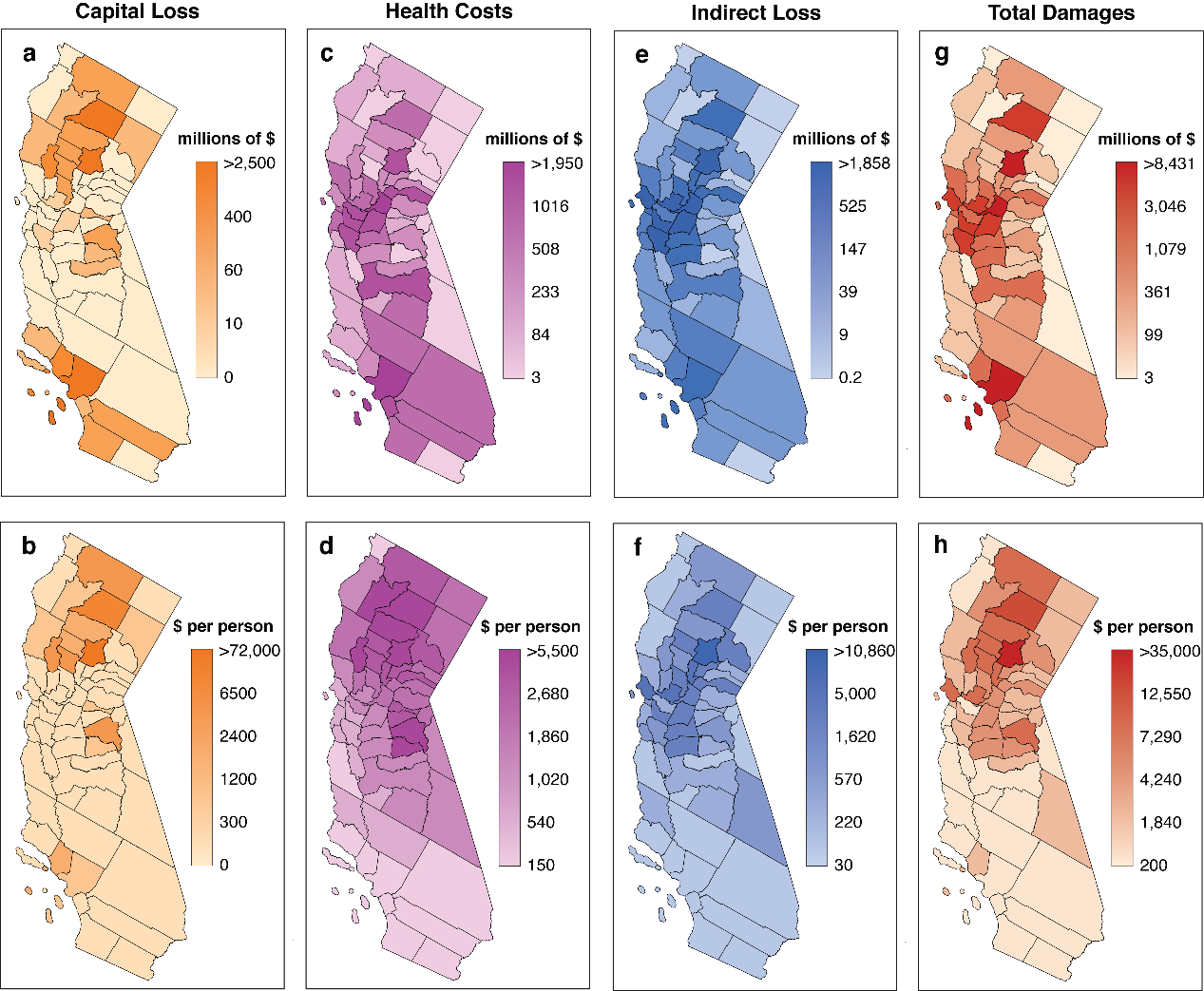Recently, Professor Guan Dabo’s research group from the Department of Earth System Science (DESS) of Tsinghua University constructed a disaster footprint model coupled with an atmospheric chemical transport model, an environmental benefit analysis system, and an economic evaluation model, and systematically evaluated the disaster footprint of the California wildfire in 2018, including the value of destroyed and damaged physical capital, health costs related to air pollution exposure, and indirect losses caused by these direct losses in regional and national supply chain networks. The research results reveal the loss composition and transmission mechanism of wildfire disasters, and provide key information for the management of wildfire disasters.
In recent years, the frequency and scale of forest fires worldwide have been increasing and expanding. Fires have played an important role in the healthy development of forest ecosystems, but if large-scale fires occur in areas where humans live, they will have complex social and economic effects. Fires will not only burn down a large number of houses and infrastructure, forcing road closures, but also release a large amount of air pollutants, affecting the health of surrounding residents. These direct impacts will cause disruptions in the supply chain, and the impact will continue to be transmitted through the supply chain, causing further economic losses. The complex impact of fires on the social economy has also brought huge challenges to disaster management. A comprehensive assessment of fire hazards and a deep understanding of its transmission mechanism have become the key to formulating disaster prevention policies and reducing disaster losses. However, the existing literature on the assessment of the impact of wildfire disasters mostly focuses on direct losses, such as the number of destroyed buildings, the value of destroyed infrastructure, and the number of deaths.
In response to this problem, Professor Guan Dabo’s research group led the establishment of a disaster footprint model that coupled physics, epidemiology, and economic models, and for the first time comprehensively estimated the economic impact of the California wildfires in 2018, including the value of destroyed and damaged capital, Health costs associated with air pollution exposure and indirect losses that are economically related to it. The results show that the total losses caused by the California wildfires in 2018 was approximately US$148.5 billion (approximately 0.7% of the US’s annual GDP), of which direct capital losses were US$27.7 billion (19%) and health costs were US$32.2 billion (22%)), the indirect loss was US$88.6 billion (59%). The assessment results indicate that most of the economic impact associated with California wildfires may be indirect and usually affect industries and regions far from the fire (for example, 52% of indirect losses in 2018 occurred outside of California).

Figure. 2018 California wildfires caused capital losses, health costs and indirect economic losses
Despite the huge amount, the direct capital losses related to the California wildfires in 2018 accounted for only 27% of the total statewide losses in the estimates of this study, and even lower proportions in the impact of certain counties and specific industry sectors. Studies have shown that health costs and indirect economic losses, which were rarely quantified before, accounted for 31.5% and 41.5% of the state’s total losses, respectively. In some cases, these indirect effects have also severely affected locations far away from the fire (such as Sacramento County) and industries (such as chemical manufacturing). Studies have shown that California wildfires have caused economic losses of $45.9 billion in other areas of the United States outside of California. Through quantification, the study draws these conclusions that were not taken seriously before but suffered huge losses in the wild fires of 2018. For example, large-scale wildfires in California or other states in the western United States did not exist in isolation. The results of the study further show that the impact of large-scale wildfires in California or other western states is not limited to areas where the fire occurred. Although the casualties and material losses caused by the fire are limited to specific communities, the impact on the economy and health is even wider. Statistics on the economic impact and scope of wildfires can provide important references for land and forest management, fire fighting and other decisions. For example, consider focusing fire prevention efforts on areas near major residential areas, important industries, or transportation infrastructure to reduce medical costs and reduce indirect losses from future fires. In addition, for the potential scale and indirect impact of wildfires, a lot of resources have been invested to reduce the risk of fires and provide support for the development of coordinated plans for the entire state and region.
This paper was published online in the journal Nature Sustainability with the title Economic footprint of California wildfires in 2018 on December 7.
Wang Daoping, a doctoral student in the School of Urban and Regional Sciences, Shanghai University of Finance and Economics, and Professor Guan Dabo from DESS of Tsinghua University are the co-first authors of the paper, and Professor Guan Dabo is the corresponding author of the paper. Professor Zhang Qiang, PhD student Lei Tianyang, Professor Gong Peng from DESS, Dr. Guannan Geng from School of Environment of Tsinghua University, Dr. Shupeng Zhu, Dr. Michael Mac Kinnon, and Prof. Steven J. Davis from the University of California, Irvine, Dr. Zheng Heran from the Norwegian University of Science and Technology, and Prof. Shao Shuai from East China University of Science and Technology are the co-authors. The research was supported by the National Natural Science Foundation of China and the National Science Foundation of the United States.
Full text link: https://doi.org/10.1038/s41893-020-00646-7
Writer: Wang Daoping
Review: Wu Haiping
Editor: Wang Jiayin